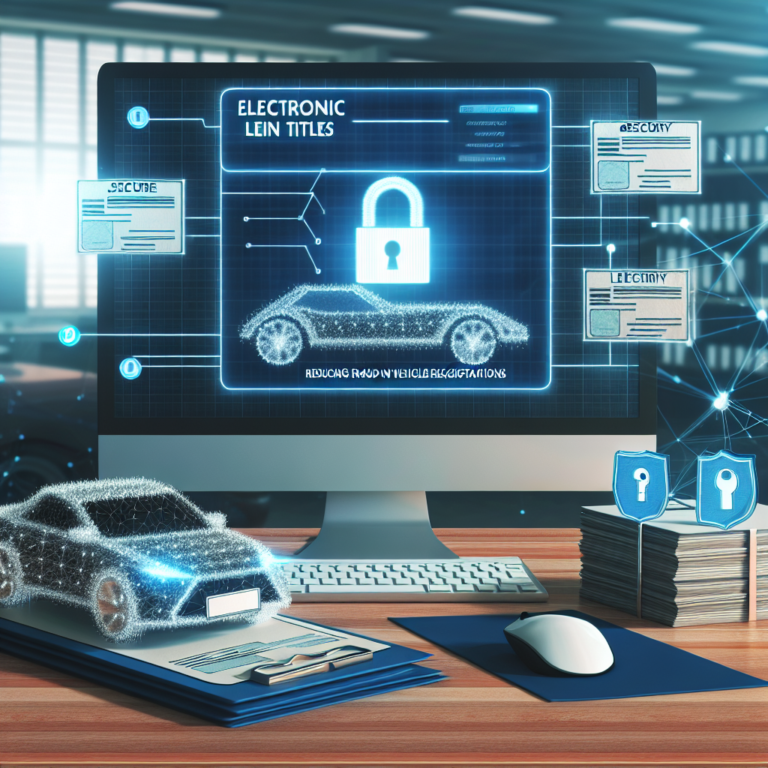In recent years, the automotive industry has witnessed a significant transformation, largely driven by advancements in technology. One of the standout innovations making waves in vehicle registration and ownership is the Electronic Lien Title (ELT) system. By transitioning from traditional paper titles to electronic formats, ELTs are reshaping the landscape of vehicle registration, providing enhanced security, efficiency, and a robust defense against fraud.
Understanding Electronic Lien Titles
An Electronic Lien Title is an electronic version of the traditional paper title. This system allows lienholders—such as banks and other financial institutions—to manage and track vehicle titles electronically. When a vehicle is financed, the lienholder submits information to a centralized database where the title is recorded digitally. This process ensures that all parties involved have up-to-date information about the vehicle’s ownership and any outstanding liens.
The Rise of Fraud in Vehicle Registrations
As vehicle ownership and financing have grown, so too has the prevalence of fraud in this sector. Unscrupulous individuals have taken advantage of vulnerabilities in the paper title system, leading to different types of fraud, including:
-
Title Washing: This occurs when a vehicle’s title is altered or replicated to hide crucial information about its previous registration, such as damage or theft.
-
Dual Financing: Fraudsters may use the same vehicle as collateral for loans from different institutions by manipulating the title.
-
Forgery: Criminals can forge signatures or documents to illegally transfer ownership of a vehicle or release a lien without proper authorization.
- Identity Theft: Paper titles can be easily stolen or manipulated, leading to cases where individuals illegally sell vehicles that do not belong to them.
How Electronic Lien Titles Combat Fraud
ELTs offer several key features that help mitigate the risk of fraud in vehicle registrations:
1. Enhanced Security
With the shift to electronic systems, sensitive information is stored digitally in secure databases. This reduces the risk of physical theft or loss of documents, making it much harder for criminals to forge titles. ELT systems incorporate sophisticated encryption and access controls, ensuring that data can only be accessed by authorized personnel.
2. Real-Time Updates
One of the greatest advantages of ELTs is the ability to provide real-time information on lien statuses. When a vehicle is financed or the lien is paid off, the changes are instantly reflected in the system. This transparency minimizes the opportunity for fraudulent activities, as all parties involved can verify the current status of a vehicle’s title.
3. Automated Error Checking
ELT systems often come equipped with automated checks that can detect discrepancies and errors in title documents. By identifying potential issues at the point of entry, these systems can prevent fraudulent transactions before they occur.
4. Streamlined Processes
The electronic nature of ELTs simplifies processes related to vehicle registration and lien management. With quicker processing times and fewer steps involved, there are fewer opportunities for fraud during title transfers. Additionally, regulatory bodies can more readily monitor transactions, enhancing compliance and oversight.
5. Increased Awareness and Training
As more institutions adopt ELT systems, financial institutions and government agencies can collaborate on training programs and awareness campaigns to educate employees about potential fraud threats and how to identify suspicious activities. A well-informed workforce is instrumental in minimizing fraud risk.
Conclusion
In an age where technology is molding every segment of our lives, the implementation of Electronic Lien Titles represents a pivotal change in the fight against fraud in vehicle registrations. By embracing digital solutions, stakeholders can significantly reduce opportunities for fraudulent activities, improve operational efficiencies, and foster greater trust in the vehicle ownership process.
As adoption rates of ELT systems continue to rise, it is imperative for all involved parties—from motor vehicle departments to financial institutions—to collaborate in optimizing these systems. By doing so, we can ensure a secure and reliable environment for vehicle ownership and financing, paving the way for a safer future in the automotive industry.


